MILWAUKEE — Southeast Wisconsin experienced historic flooding over the weekend, leading to numerous reports of stranded drivers, power outages and emergency rescues.
Tyler Borchardt described his frightening experience after he found himself "stuck" in flood water while picking his mom up from the hospital.
“I didn't know where the flooding was or anything until I was experiencing it,” he said.
The National Weather Service issued a flash flood warning shortly after 8 p.m. Saturday, but a critical cell phone alert wasn't dispatched until after 1 a.m. Sunday—leaving many residents unaware of the worsening conditions.
"I knew it was raining all day, and I wasn't surprised to see water here and there," Borchardt said.
However, early Sunday morning, he found himself trapped by rising waters near 124th and Cleveland.
“North there was flooding, South there was flooding, East there was flooding and we tried to go back West and now the water we just went through was even deeper,” he added.
Before 9 p.m. Saturday, reports of stranded drivers began to emerge, and the severity escalated with neighborhoods from Milwaukee to Waukesha facing evacuation orders and structural collapses.
Watch: National Weather Service explains timing of Flash Flood Warnings after historic flooding
“I don't think I saw any alerts until I actually was trapped," said Borchardt.
Around 1 a.m., the National Weather Service upgraded the flash flood warning. Tim Halbach, Warning Coordination Meteorologist for the National Weather Service, addressed concerns regarding the delay in alerting the public.
“That's just part of a normal severe weather event for us where we're trying to get the information on how bad the situation is, and sometimes with these reports, we have to verify how accurate it is,” he said.
Halbach explained that upgrading a warning to the "considerable" level, which triggers cell phone alerts, is a more complex process.
“The challenge with that level of a warning, it doesn't go on cell phones," he stated. “The second level, what we consider a considerable warning, is when we've gotten reports that things are really bad or that it's more than just your normal flash flood.”
Internal communications between the Weather Service and media indicate that some meteorologists felt urgent reports should have prompted a quicker response.
Halbach acknowledged, “That’s what we’ll have to go back and look at.”
He emphasized that the goal is to learn from these events to ensure the safety of residents in the future.
In the aftermath of the floods, affected communities are left to recover, while emergency officials assess how to improve response efforts for future severe weather events.
It’s about time to watch on your time. Stream local news and weather 24/7 by searching for “TMJ4” on your device.
Available for download on Roku, Apple TV, Amazon Fire TV, and more.








